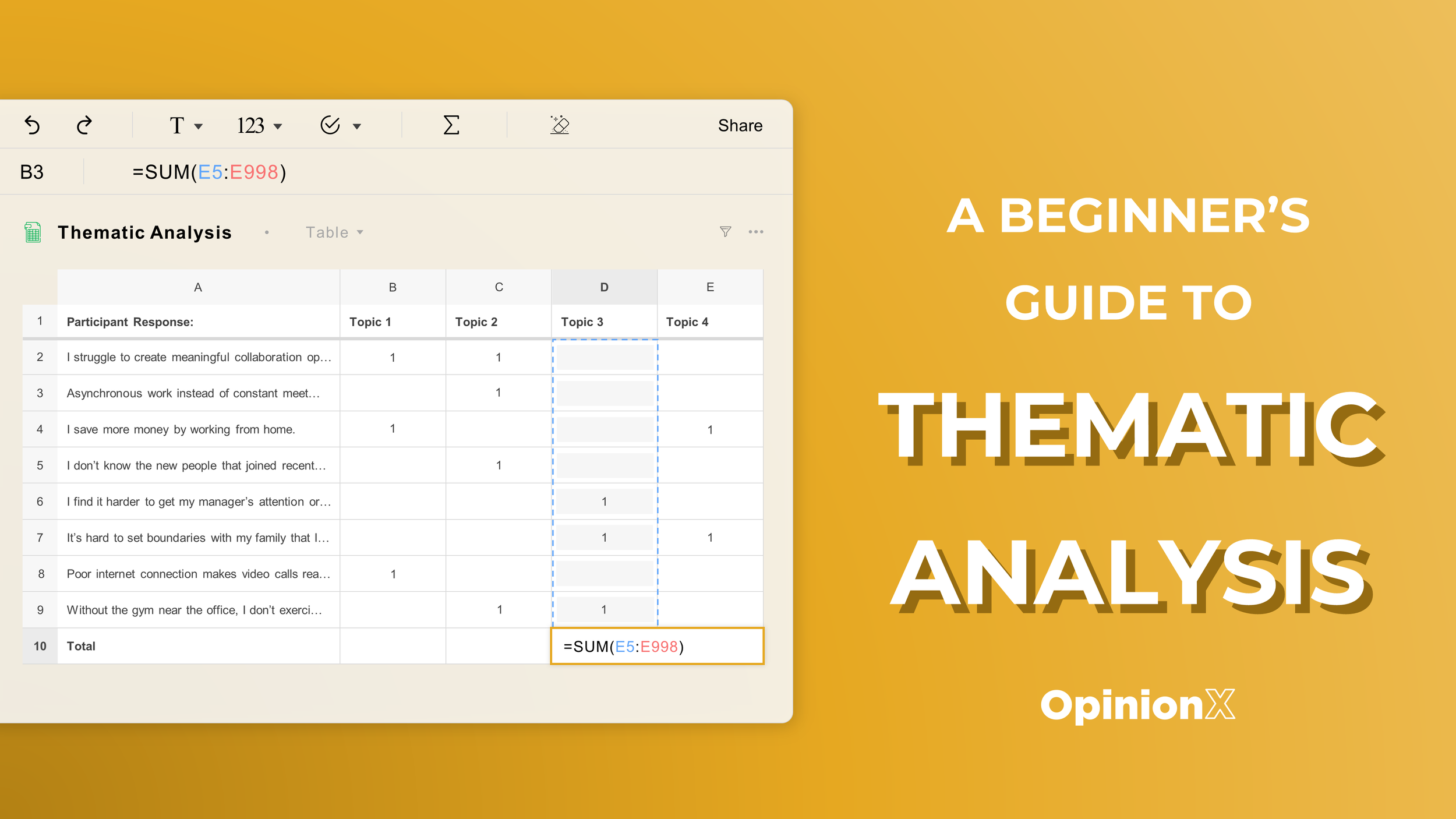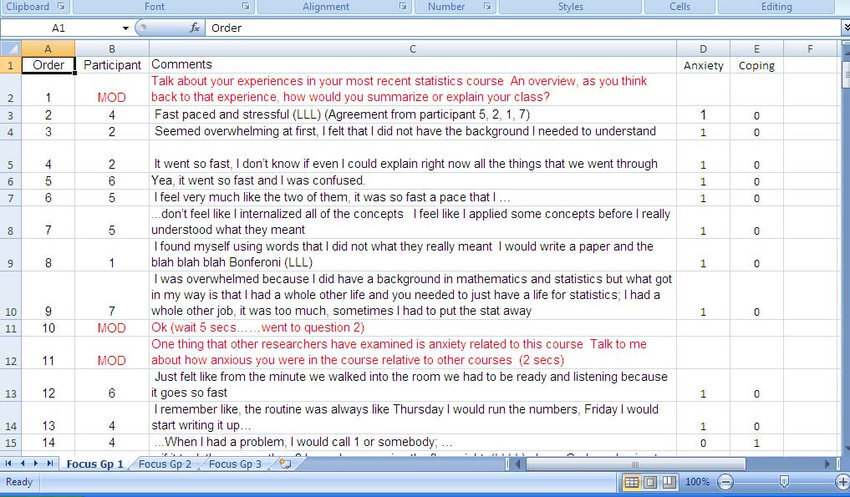A Beginner’s Guide to Thematic Analysis
Qualitative research is a great way to understand why people behave the way they do. However, what seems like a solid methodology choice can quickly turn into a mountain of transcripts and spreadsheets of answers. How do researchers tackle these overwhelming datasets? A common answer is thematic analysis.
In this guide you'll find explanations of what thematic analysis is, when it's used, the steps involved, real life examples, the pros and cons of thematic analysis, and cutting-edge alternative methods of analysis.
What is thematic analysis?
Thematic analysis is a structured method of analyzing qualitative data. It's a framework used to turn unstructured texts into a set of codes which are used to derive themes and meaning from large qualitative studies like user interviews, diary studies and open-ended surveys.
Thematic analysis is an umbrella term for lots of broadly similar research practices, like qualitative coding, textual analysis, content analysis and more. Let's avoid getting stuck into which term means what here — what we're interested in is how this structured approach helps researchers to understand the meaning within large qualitative datasets.
The process for conducting thematic analysis is pretty well established. After becoming familiar with the data, researchers give interesting highlights a code, which collectively get grouped into themes that are reviewed to weave together a set of conclusions that gets distributed in a report. We'll dig into these steps further after the next question.
An example of a spreadsheet used during thematic analysis of qualitative research.
When is thematic analysis used?
Thematic analysis is used when you're trying to distill insights about people's views, opinions, knowledge, experiences or values from a qualitative dataset. It one of the most popular qualitative analysis methods in both academic and commercial settings.
The analysis process takes place after you've collected all of your qualitative data. While it is common to have an idea upfront about which themes may emerge based on assumption mapping, it's best practice to gather your full dataset before engaging in any thematic analysis.
What steps are involved in thematic analysis?
While there are different variations of thematic analysis, particularly within academia, the process always takes place using the same general steps:
1 - Get Familiar with the Data
Read through all of the transcripts and responses available to become familiar with your data.
2 - Create Codes
Highlight sections of text – usually phrases or sentences – and come up with shorthand labels or 'codes' to describe their content.
3 - Generate Initial Themes
Examine your codes and categorize them under suitable themes. Below are the common approaches to developing themes:
Inductive approach: allow the data to determine your themes.
Deductive approach: come to the data with some preconceived themes you expect to find reflected there, based on theory, established assumptions or existing knowledge.
You should also make a distinction between a semantic and latent approach.
Semantic approach: analyze the explicit content of the data.
Latent approach: read into the subtext and assumptions underlying the data.
4 - Review Themes
Refine your themes by spliting, combining or discarding them now that you've digested your full dataset.
5 - Determine the Story
Crafting the story that emerges from each theme is essential for landing the insights identified with your stakeholders. You might also find cross-thematic insights in your data — that's not surprising! It's common for people to reference more than one topic during their research engagement.
6 - Review and Report
Turn that story into a shareable, easy-to-digest document detailing the relationship between your new findings and old knowledge while recognizing the limitations of your research. You may also want to include recommendations for the best next steps in your project.
What is an example of thematic analysis in action?
Ajantha Suriyanarayanan is the Director of Consumer Insights at Art.com, the online e-commerce platform that brings easily accessible, top-notch art to everyone. Ajantha describes Art.com as a "consumer-obsessed" company. She says that "knowing where the pain points are and knowing where we’re receiving kudus from people is huge.
But "with the limited resources we have, we need to be intelligent about where we’re dedicating our time. Do we want to do something new and cool, or do we want to fix issues that our consumers have surfaced?”
The team at Art.com developed a two-step process to review open-ended consumer comments. "One person was manually reading the comments and then classifying them himself." They developed a framework for thematic analysis using an Excel spreadsheet with pre-set tabs alongside keyword analysis and natural language processing tools to create their codes and themes for further analysis.
What are the advantages of thematic analysis?
While thematic analysis can become a little overwhelming if you're working with a large dataset, the beauty of this analysis method is just how accessible and simple it is. Anybody can use the 6 steps outlined above to thematically analyse their qualitative research output. Experience will help you to dig deeper, but even a fresh newbie to the world of research can utilise this analysis method.
Thematic analysis is suuuuuper flexible. It can be used on loads of different datasets, from interview and focus group transcripts to diary study and open-ended survey responses.
If you approach thematic analysis from a blank slate, you can create a very comprehensive understading of your data. While assumptions often hold a strong influence over all qualitative analysis methods, you can do a good job of eliminating their influence if you have enough time to dedicate to thematic analysis.
What are the limitations of thematic analysis?
Thematic analysis is a manual and time consuming process. Grouping thousands of survey responses into themes can take days or even weeks that teams at fast moving companies rarely have.
The manual aspect of thematic analysis means it becomes siloed work with one person taking on the bulk of the work. Ajantha says that this is a particular pain of their analysis process at Art.com, "having only one person compiling the insights report won’t instill consumer feedback into the minds of people that need to have it installed in their minds.”
Thematic analysis assumes that the more people who reference a theme, the more important that theme is. While this is an understandable approach for gathering feedback from existing users, when you're working on discovery research projects, assuming that frequency means importance is a flawed approach.
What alternatives are there to thematic analysis?
Gathering open-ended feedback is a great way to learn about your customers opinions without limiting them to your own pre-convinced priorities through a multiple choice list. As Ajantha said, thematic analysis takes a long time and when you're analysing an 'always-open' channel like customer feedback, it can quickly become overwhelming and siloed. Rather than limiting the richness of open-ended responses, implement natural language processing tools like Thematic to make sense of these queries at scale.
Discovery projects — where you're trying to learn brand new things about people through proactive primary research — is much more ad hoc than gathering feedback. Examples of this type of research would include growing to a new customer segment, building a new product/feature, or expanding to cater for new use cases.
Typically carried out a shorter burst like a design thinking sprint, discovery research is open-ended by nature and often time-sensitive (the longer analysis takes, the more delayed the project gets). For these projects, turning data into codes and themes is going to take a lot longer as you have no pre-determined categories to work from. As you are trying to find the most impactful unmet user need or pain, assuming that whatever topic had the highest number of occurances is also most important will mislead your outcome.
Instead, identify which opinion resonates the strongest with the largest number of your target segment. This priority mapping method presents a quick and accessible alternative to assumption mapping for the start of a new project. OpinionX offers a unique survey tool that turn an unstructured collection of user-generated opinions into a prioritized list in just one click. Check out how OpinionX can help you to carry out deeper discovery research 4x faster than traditional methods.
Identifying user priorities using discovery research platform OpinionX
Conclusion
Despite its time consuming and manual nature, thematic analysis is one of the most popular methods of analyzing qualitative research. It's accessible and flexible approach is a solid option for larger teams with longer timelines and ad hoc projects. For fast-paced teams, discovery research tools like OpinionX offer lightweight alternatives for priority mapping and understanding users' biggest unmet needs in a fraction of the time of traditional thematic analysis.



